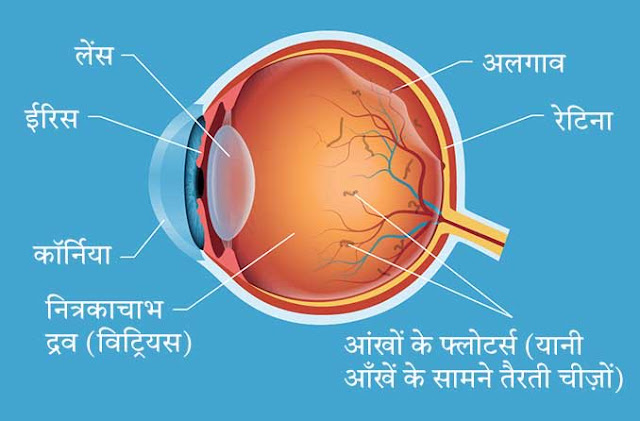नेत्र मण्डल – 5
नेत्र के आयाम का तृतीयांश कृष्ण मण्डल होता है तथा कृष्ण मण्डल का सातवां भाग दृष्टि मण्डल होता है।
- पक्ष्म मण्डल – Eye-lashes (Outermost)
- वर्त्म मण्डल – Eye-lids
- श्वेत मण्डल – Conjuctival sac
- कृष्ण मण्डल – Cornea
- दृष्टि मण्डल – Pupil (Innermost)
नेत्र संधि – 6
॰ सन्धि अर्थात् Junctions
- पक्ष्मवर्त्मगत सन्धि – Lid Margin (Outermost)
- वर्त्मशुक्लगत सन्धि – Fornix
- शुक्लकृष्णगत सन्धि – Limbus
- कृष्णदृष्टिगत सन्धि – Pupillary Margin
- कनीनकगत सन्धि – Inner Canthus
- अपाङ्गगत सन्धि – Outer Canthus (Innermost)
नेत्र पटल :
- दो पटल वर्त्मगत तथा चार पटल अक्षिगोलक में होते हैं।इन्हीं चार पटलों में तिमिर रोग होता है ।
- आचार्य वाग्भट मतानुसार नेत्र के कृष्ण मण्डल (Cornea) की उत्पत्ति रक्तवह स्रोतस् से होती है एवं श्वेत मण्डल (Sclera) की उत्पत्ति कफवह स्रोतस् से होती है।
- शरीरगत रक्त तेज का प्रतिनिधित्व करता है तथा कफ जल का बोध कराता है। अतः प्रथम मण्डल से Sclera और Cornea को ले सकते हैं।
प्रथम पटल – तेजोजलाश्रित – Sclera and Cornea :
- जब दोष प्रथम पटल में उपस्थित होते हैं, तो रोगी सभी पदार्थों को अव्यक्त (अस्पष्ट) देखता है।
- नेत्र के आकार प्रमाण में त्रुटि से भी रोगी अस्पष्ट देखता है जिससे कि परावर्तनजन्य विकार (Myopia, Astigmatism) होते हैं।
- Refractive errors may be produced by change in the axis and curvature of the cornea.
द्वितीय पटल – मांसाश्रित – Uveal Tissue
- मांस में बन्धन गुण होता है जो कि Uveal tissue में होता है। मांस शरीर की पुष्टि करता है, नेत्र की पुष्टि Uveal tissue करता है। Uveal Tissue में संकुचन और विस्फारण का गुण होता है।
- Uveal tissue have properties of constriction and dilation.
- द्वितीय पटल में दोष होने से दृष्टि दुर्बल हो जाती है i.e., Dimness of vision.
- There are accommodation anomalies. Accommodation is brought about by ciliary body and physical component of the iris.
- Pathology in 2nd Patala leads to scotoma or blind area. Scotoma can be due to inflammation in the posterior part of the uveal tract.
- Symptoms of invasion of doshas in second patala are – Diplopia (Double vision), Micropsia (Objects are perceived to be smaller than they actually are), Metamorphopsia, Visual field defect.
तृतीय पटल – मेदोऽऽश्रित – Cortical Part of lens
- The part of the eye inner to the uveal tract is Cortical part of lens is having Meda like properties i.e. viscous, lipoproteinaceous in nature and whitish in colour.
- Clinical features of third patala anomaly are similar to opacity of cortical part of lens.
- तृतीय पटल में दोष स्थित होने पर निम्न लक्षण पाये जाते हैं –
॰ दृष्टि मण्डल का रंजन होना ।
॰ दृष्टि का क्रमशः मन्द होना।
॰ बड़ी वस्तुओं का दिखाई न देना।
॰ एक वस्तु के दो, तीन या अनेक रूप दिखते हैं।
॰ दोष स्थिति अनुसार दृष्टि क्षेत्र में विकृति। - Change in the colour of the lens can be due to opacity in cortical part of lens. The visual symptoms due to cataract depend on the site of lens opacity and degree of opacification of lens. Patients complains of polynomials i.e. doubling or trebling of objects.
चतुर्थ पटल – अस्थ्याश्रित – Nucleus of the lens
- It is constituted by Asthi i.e. hard tissue which is supportive in nature. Inner to cortical part of lens, hard supportive structure is nuclear part of lens. Moreever clinical features of fourth patala points toward nuclear part of lens.
- Complete loss of vision occurs if doshas are situated in the fourth patala; however, patient can view bright object if the condition is not serious. Thus the fourth patala is the nucleus of the lens.
Note : नेत्र पटल परीक्षा की दृष्टि से important topic है।





